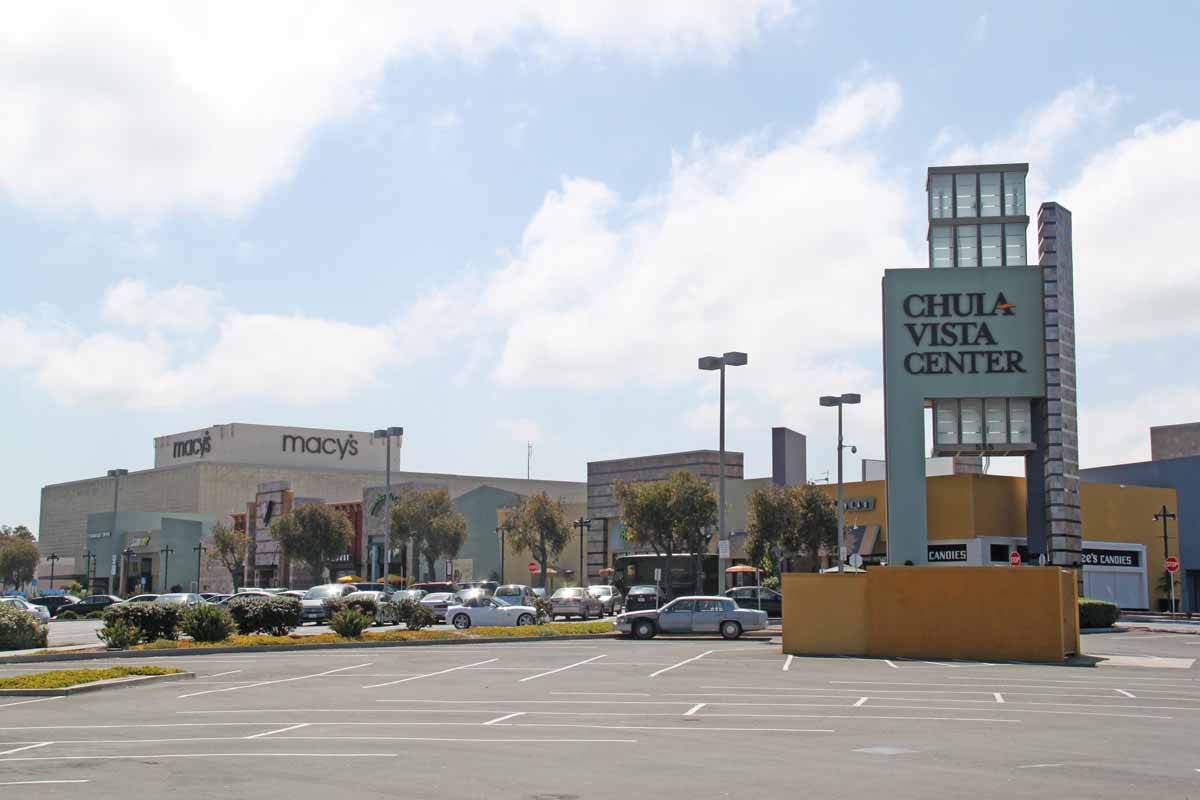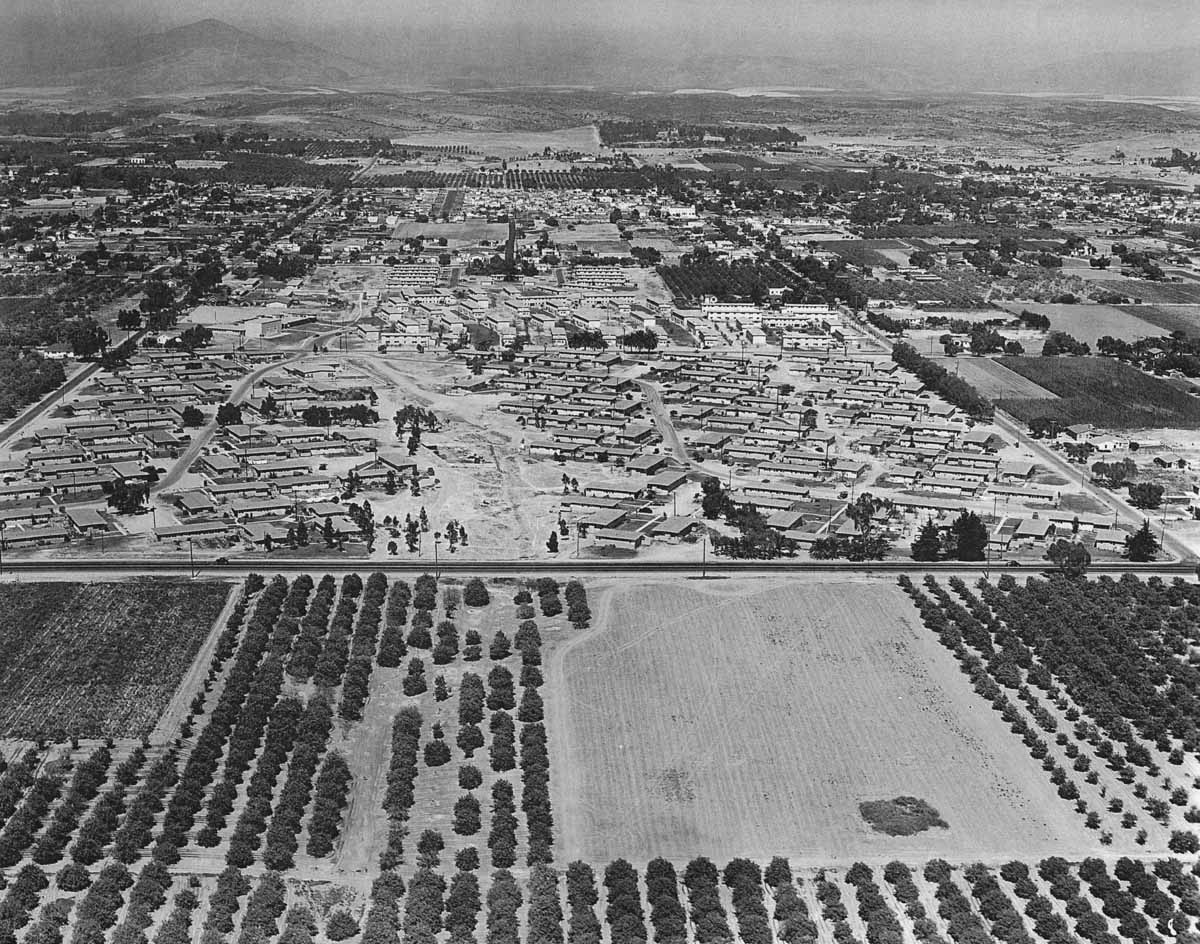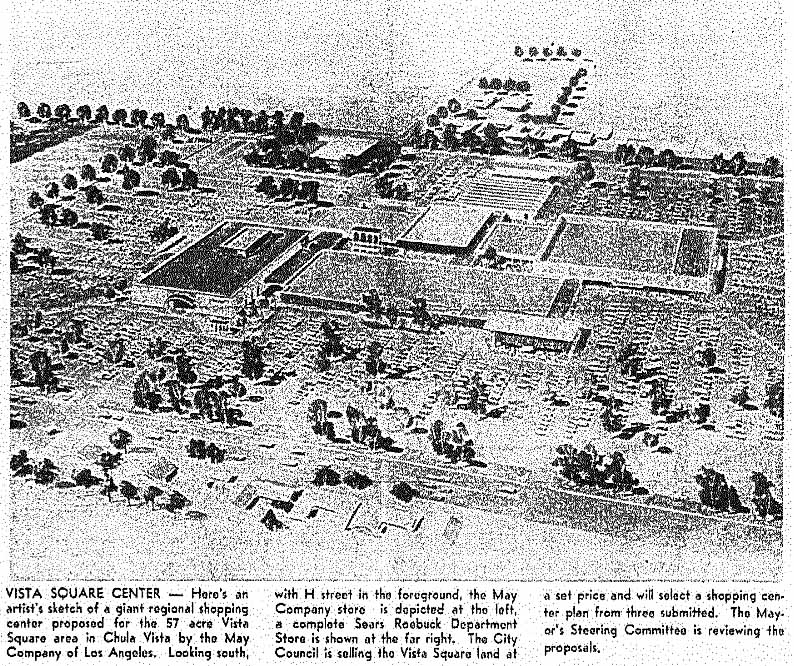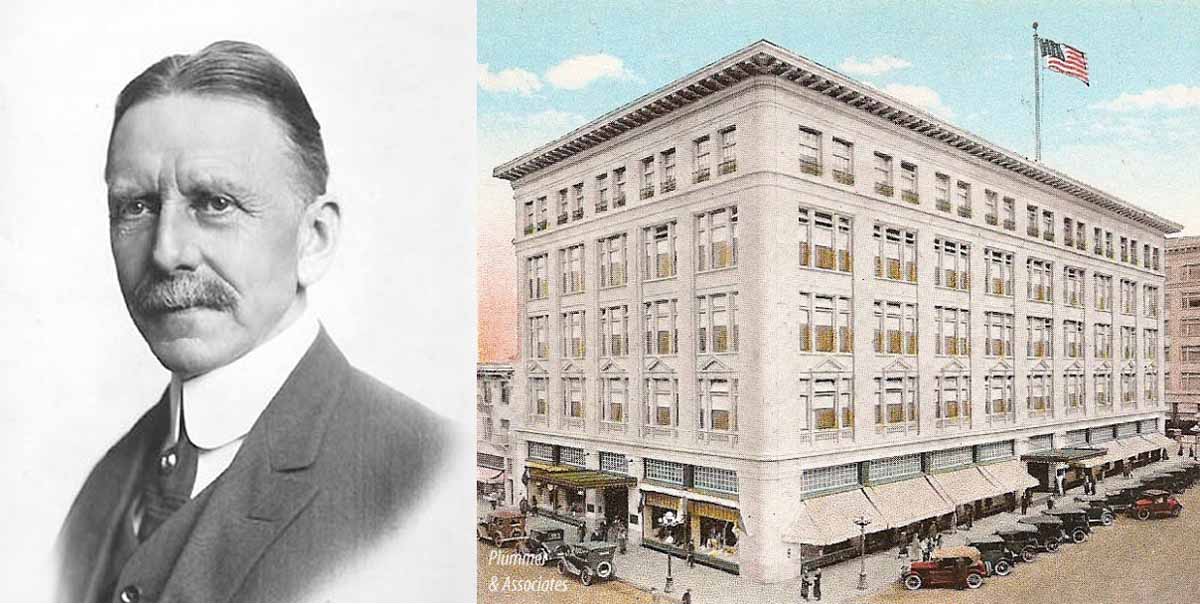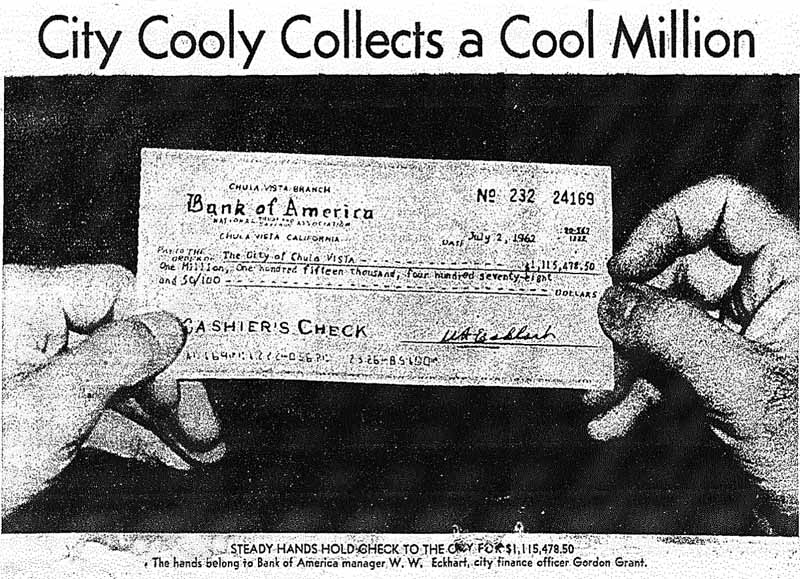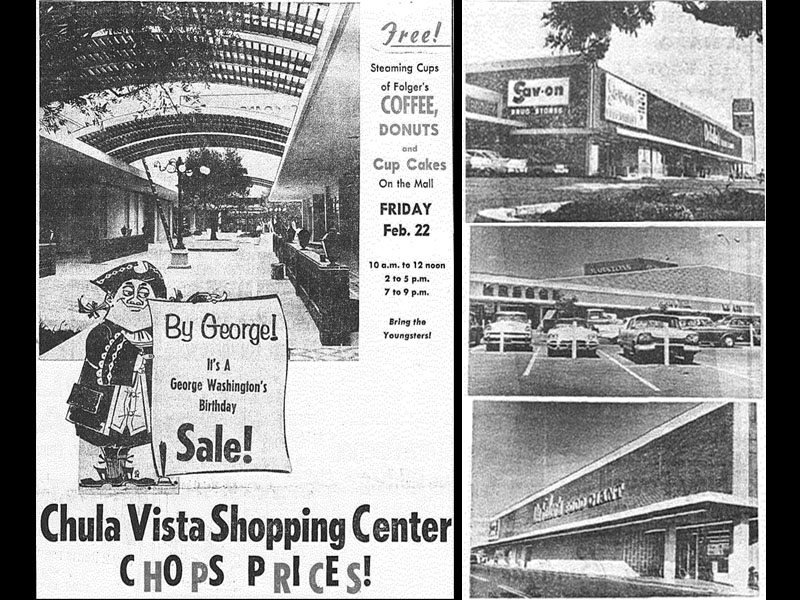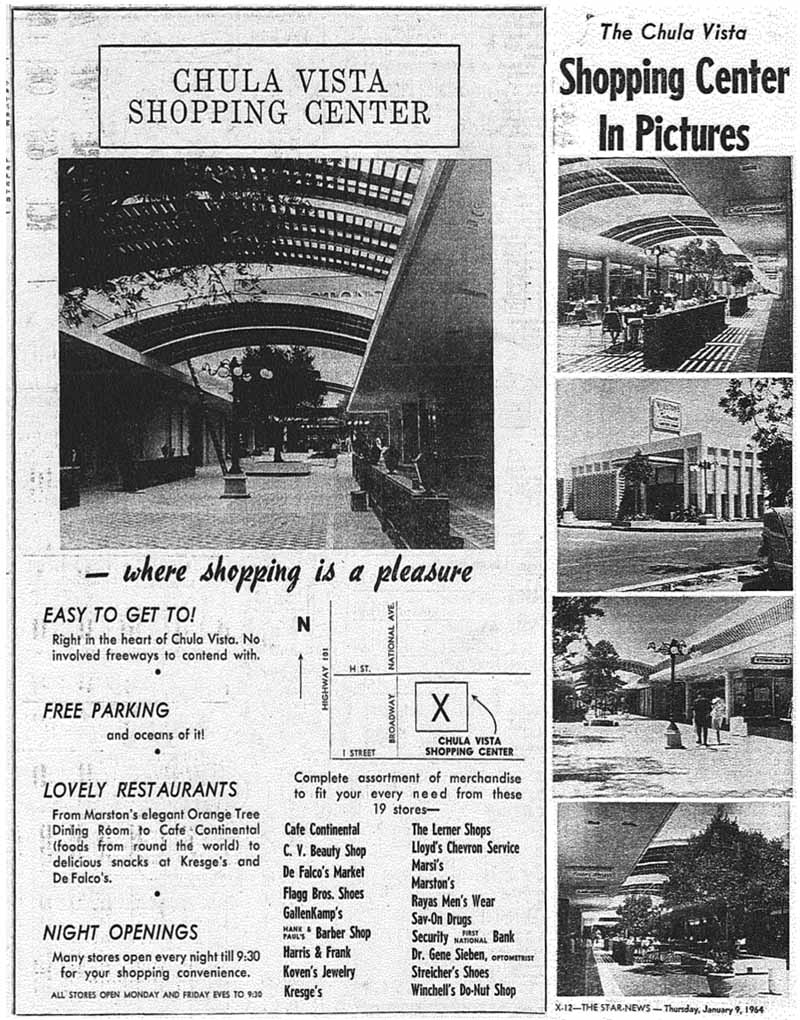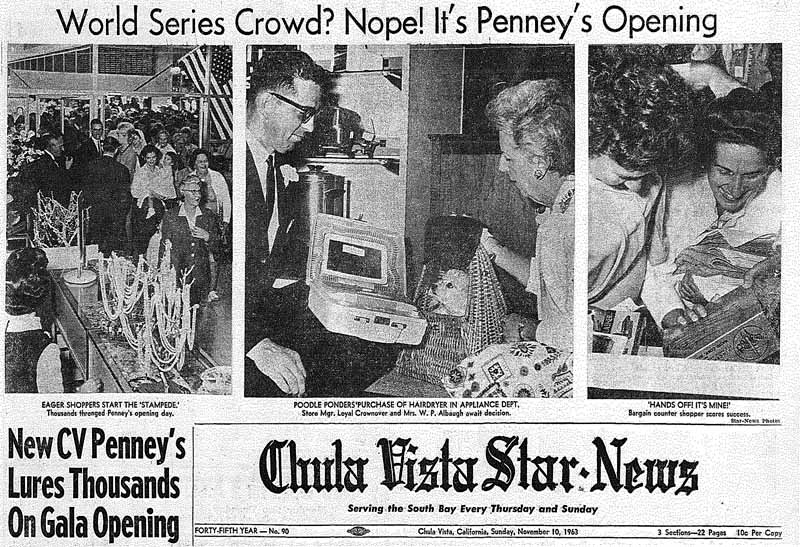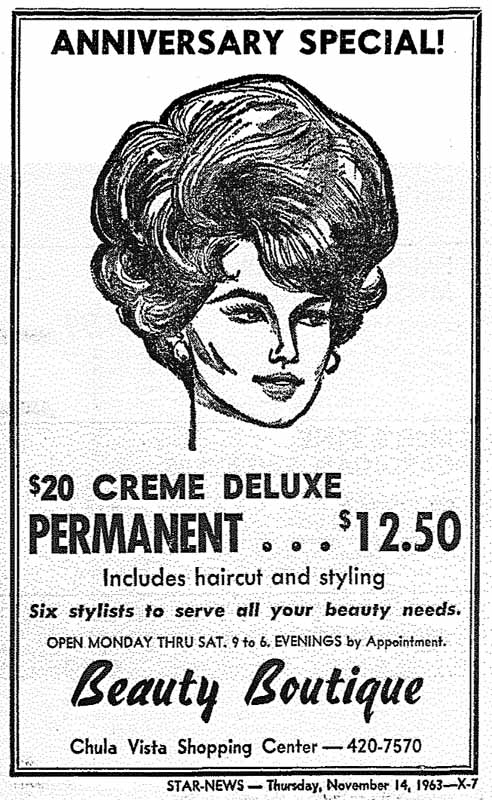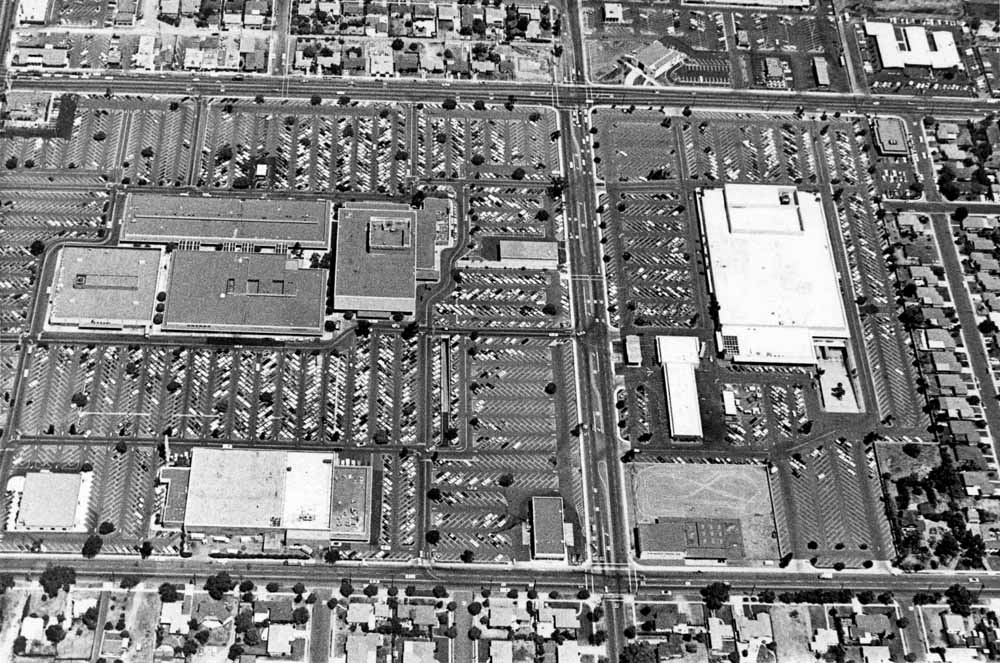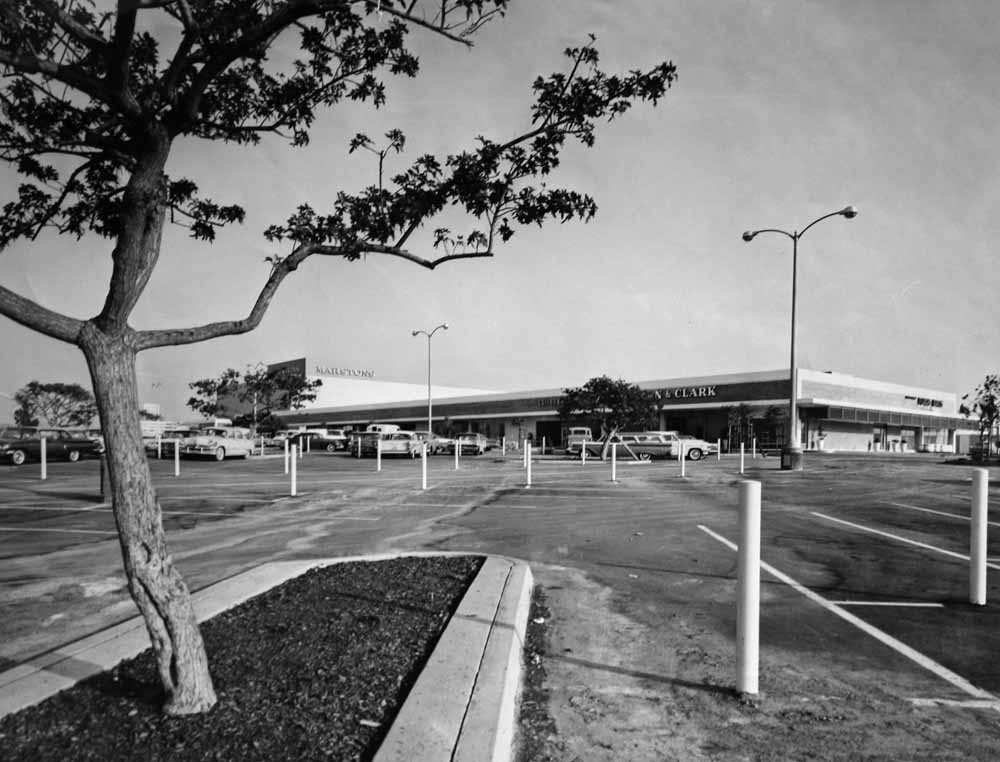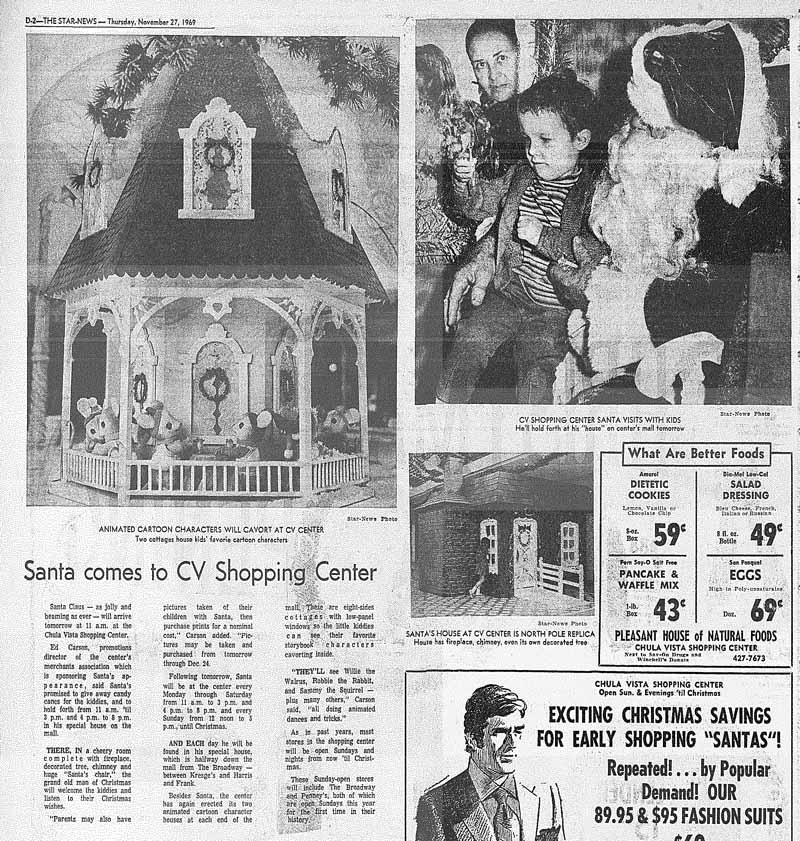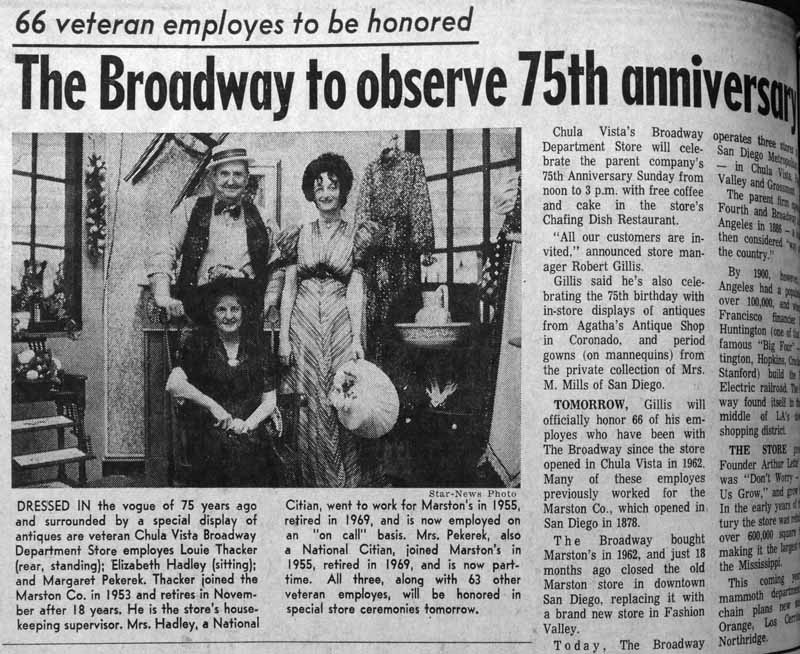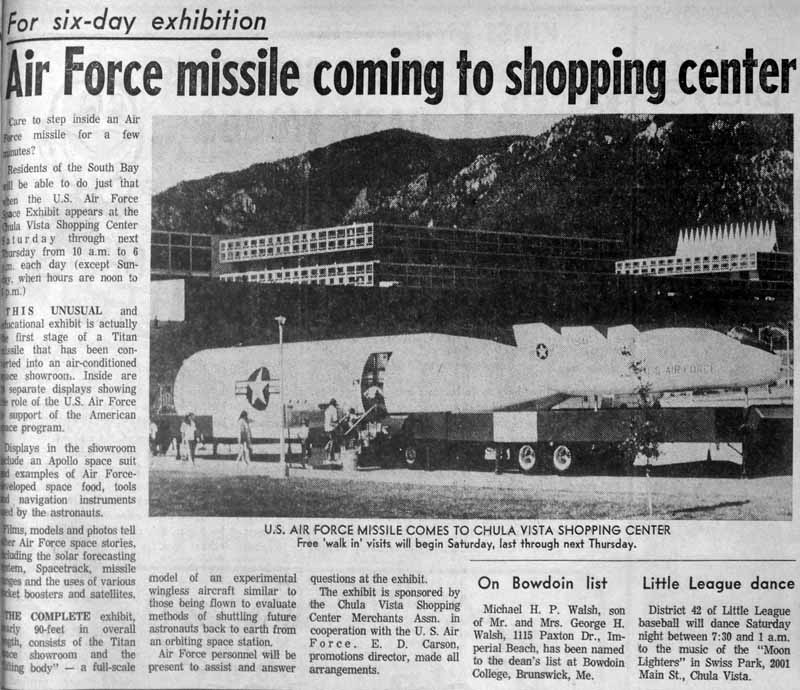|
The Chula Vista Shopping Center
a chronology and notes by Steve Schoenherr May 25, 2012
Chula Vista Center July 12, 2011
1948 - Shopping centers in the South Bay began with the Miracle Mile on Palm Avenue in Imperial Beach in 1948, South Bay Plaza in National City in 1955, CV Plaza at 3rd and H by J. M. Bannister in 1956, Country Club Square at Hilltop & Naples in 1959, the CV Center with Alpha Beta in 1960, across the street from the F Street School, the Bonita Village Shopping Center in Dec. 1960. 1955/08/04 - Front page story on a proposed shopping center in heart of city - this is the first time it is mentioned, "of a scope to rival anything in the entire South Bay district" to be developed by J. M. Bannister Co. who owned the property where Mayfair Market located at 3rd and H, sought rezoning of land for a department store, a W. T. Grant store, variety store, drug store. (Star-News, Aug. 4, 1955. ) 1956/12/11 - At the Chula Vista City Council meeting, a letter was read from Jack H. Perrine proposing that the Vista Square Housing land be used for a planned and attractive Shopping Center. The letter was filed. A letter was read from the National City-Chula Vista Board of Realtors suggesting that the tenants of the Vista Square project be notified immediately of the City's desire to liquidate the project in October, 1957 in order that they may relocate prior to that time. The letter was filed. A letter was read from the Chamber of Commerce encouraging the Council to terminate operation of Vista Square housing in October, 1957. Mr Sorensen of the Chamber of Commerce spoke in support of the letter. No action taken. (City Council Minutes Dec. 11, 1956) 1957 - One of the turning points in the pattern of San Diego's growth was the decision by the May Company of Los Angeles in 1957 to build a shopping center in Mission Valley near the junction of U.S. Highways 80 and 395 (now Interstate 8 and State 163). This concept of a suburban "town center" had already been built in Linda Vista and at South Bay Plaza. (Fenton mss ch. 5)
Vista Square, June 1946. Broadway (then known as National Avenue) runs across the center, H Street is on the left, I Street is on the right.
1959 - Chula Vista City Council received permission from the Navy to demolish the remaining 299 duplex units of the Vista Square housing project (Cal 4259) built in 1943. One section of the 50 acres site had 150 buildings housing the 299 units, the other section had 38 buildings with 304 units.(Star-News, Feb. 12, 1959.) Alice Tallent Dumas recalled living in the government project, in an old house where Penney's located. Her family came from Oklahoma in 1942, parents worked at Rohr, she was one of the first 3 cheerleaders of the CVHS when it began at Brown Field in 1948. ( Dumas, Alice Tallent, interview Sept. 24, 2010 by Susan Walter. ) 1959/01/15 - Schioichi Yonekura sold property along H Street for the Chula Vista Shopping Center. ("Appraisal of Vista Square, Chula Vista, County of San Diego," made for the City of Chula Vista by Ewart W. Goodwin and Richard B. Miller, 1959.) Yonekura had farmed between H and I street east of National Avenue since the 1930s and had lost most of his property to the federal government when the Vista Square housing project was built. Several other property owners were displaced by the housing project in 1942. George and Maria Schertzer had farmed 10 acres at H Street and 5th Avenue since 1909. Jay Hicks had operated a bulb nursery at 571 National Avenue since the 1920s. 1959/03/01 - The study of other shopping centers indicates that it takes approximately three years from the time a community center is planned until the center is constructed. Therefore, it is felt that the best use to which the land might be put is a site for community shopping center wherein the major portion would be put to a commercial use and the balance to a multiple family use.The parcel is traversed by a small drainage depression. ("Appraisal of Vista Square, Chula Vista, County of San Diego," made for the City of Chula Vista by Ewart W. Goodwin, and Richard B. Miller, 1959.) 1959/03/15 - The Goodwin and Miller appraisal report of Vista Square recommended regional shopping center for the 55 acres, set value at $1,174,700 -- Broadway department store in favor of the shopping center (Star-News, March 15, 1959. )
Proposed drawing of a Vista Square Shopping Center in the Star-News Sept. 6, 1959
1959/09/06 - Vista Square shopping Center proposals are studied - front page drawing of the future shopping center on front page (Star-News, Sept. 6, 1959. ) 1959/09/24 - new shopping center at Vista Square to be called Vista Plaza, will included $2m Broadway dept store and a Sears store and a Penney's store. (Star-News, Sept. 24, 1959. ) 1960 - Then and Now - The Vista Square Housing Project has been removed. A Boys Club located at 495 I Street has been built on part of the site. Private homes have been built on another part. The rest of the property, fifty acres, was purchased to be developed as a shopping center. It is now being developed as "The Chula Vista Shopping Center" and will be known as "Marston's Chula Vista." Hilltop Housing Project has also been removed. In its place schools and school offices are now located. The Hilltop Junior High School, the Education Center for the Chula Vista City School District, and the Ann Daly School for the severely retarded child have replaced the housing project. ( Krantz, Thelma A. and Frances L. Read. Chula Vista and Community. Part One. A History for Children. Chula Vista CA: Chula Vista City School District, 1961. ) 1960/04/14 - Council officially approved plans for the $25m regional shopping center, will be leased to Broadway-Hale, 40 acres of the old Vista Square housing project, plus a 15-acre parcel east of 5th Avenue. (Star-News, Apr. 14, 1960. )
George Marston and his landmark store at 5th and C in San Diego built in 1912. It was demolished with the building of Horton Plaza in 1985.
1961 - Marston's was purchased by the Broadway Stores that had merged with Hale Brothers of San Francisco in 1950. Marston's continued to operate independently for a few years before taking the Broadway name. George White Marston was born in 1850 in Wisconsin, came to San Diego Oct. 1870. Marston's first job in San Diego was as a clerk in the Horton House hotel, which had opened just one week before his arrival. Among his duties there was brushing the dust off visitors' clothing before they entered the hotel. After six months at Horton House, he took a job with Aaron Pauly and Sons general merchandise store, warehouse and wharf office. Starting in 1872, he clerked for storekeeper Joseph Nash for five years before he and a partner Charles Hamilton bought out Nash for $10,000. In 1872, Marston and Hamilton helped open a free reading room.. When he died in 1946 at age 96, George Marston was truly regarded as "San Diego's First Citizen." (George White Marston Collection, Papers and records, 18701946, MS 219, San Diego History Center) His son, Arthur Hamilton Marston, married Peggy Day and lived in Bonita, and were founders of the Good Shepherd Church. They had 4 children, including son George Marston who lived in Chula Vista at 581 Del Mar. (Gwen Day McCaughey interview Sept. 27, 2008, at 279 J Street, Chula Vista CA) 1961/05/04 - excavation of basement of the Marston store started this week. The store will have 3 stories, including a Coffee shop and the Orange Tree Dining Room, and 200,000 sq ft (downtown Marston's was 240,000 sq ft) (Star-News, May 4, 1961. ) 1961/08/24 - Council budgeted $55,000 to build storm drains at H Street and Broadway, will drain the shopping center. (Star-News, Aug. 24, 1961. ) 1961/12/07 - front page photos show high tower used for construction of Marston store "CV: Bigger and Better" (Star-News, Dec. 7, 1961. ) 1962/02/01 - Food Giant to build store in Chula Vista Shopping Center at 551 I St. (Star-News, Feb. 1, 1962. ) 1962/06/21 - Sav-On Drug Store will be the first store to open in new CV Shopping Center on H St, will hire 55 employees, is now stocking up the store at the southeast end of the center behind the Security First National Bank that will open in Oct. (Star-News, June 21, 1962. )
1962/07/05 - The city got its largest check in history, $1,115,478.50 from Broadway-Hale for 46 acre lot of the Chula Vista Shopping Center. (Star-News, July 5, 1962. ) 1962/07/12 - Sav-On drug store is first store to open today in new CV shopping center (Star-News, July 12, 1962. ) 1962/11/12 - The official opening of the Chula Vista Shopping Center was Nov. 12, 1962. It was built at Broadway and H Street on the 40-acre site of the Vista Square war housing project. In 1959, planning began for what was originally called the "Vista Plaza Shopping Center" (using part of the name of the popular South Bay Plaza shopping center that opened in National City in 1954) Broadway-Hale leased the site in 1960, and planned a 3-story Marston department store with basement for 4500 as civil defense shelter. The shopping center was renamed the Chula Vista Shopping Center and the first store to open was Sav-On in July 1962. Other stores opened later: Kresge in Feb. 1963, Penney's in Nov. 1963 with the city's 1st escalator, and Sears last on Feb. 21, 1966. The Chula Vista Shopping Center featured an mall 640 feet long and 40 feet wide. The center fountain duplicated the Alhambra palace in Granada, Spain. 1963/01/03 - Kresge to open store in CV Shopping Center Feb. 14 (Star-News, Jan. 3, 1963. )
Shopping Center pictures from the Star-News Mar. 14, 1963 and Jan. 9, 1964.
Shopping Center pictures from the Star-News Mar. 14, 1963 and Jan. 9, 1964.
1963/04/25 - Marston store basement will stock civil defense supplies, can hold 4500 and two weeks of supplies (Star-News, Apr. 25, 1963. ) 1963/08/15 - Sears to build big store of 104,000 sq ft in the CV Shopping Center on 15 acres across 5th ave from Marston's. The site has 4 parcels, including the half acre city corporation yard at 456 H St, and the Golden Arrow Dairy restaurant at 5th and H St, and 14 acres held by Broadway-Hale. Sears at one point was interested in the Boys Club at 5th and I st. (Star-News, Aug. 15, 1963. )
1963/11/10 - Penney's opened at 10 am Thursday, shoppers poured into store (photos), 1200 waiting outside for doors to open, made 5000 sales first day, store hired 172 out of 2000 applicants, store had the first escalator in CV (Star-News, Nov. 10, 1963. )
Beauty Boutique ad from the Star-News Nov. 14, 1963
1963/11/21 - cake served at 1st anniversary of CV Shopping Center, with emcee Regis Philbin (Star-News, Nov. 21, 1963.) 1964/01/02 - Meet your street foreman, Bill Lester, his 46 men are in charge of CV's 135 miles of streets, has 35 pieces of equipment, his office was at the old maintenance yard at 456 H Street now taken over by the CV Shopping Center. (Star-News, Jan. 2, 1964.) 1964/03/15 - 25 tons civil defense supplies from Navy Supply Depot were transported in Rohr trucks to Marston's basement, unloaded by Navy and Rohr volunteers (Star-News, Mar. 15, 1964.)
Chula Vista Center ca. 1965 looking north, with Fifth Avenue in the center.
1964/06/18 - Penney's Auto Center to open today at CV Shopping Center, its first in southern California (Star-News, June 18, 1964. ) 1964/11/12 - special supplement for the 2nd anniversary of CV Shopping Center, opened Nov. 1962 with 15 stores, now has 26 (Star-News, Nov. 12, 1964. ) 1964/11/23 - Santa will arrive Friday Nov. 27 at CV Shopping Center on an elephant, riding down Broadway from E St with police escort, to start 3rd Christmas season -- Nov. 26 - Santa will arrive downtown 3rd Ave Monday Nov. 30 on a fire truck, SW College brass choir will give permanence at 8 pm (Star-News, Nov. 23, 1964. ) 1965/01/28 - new Sears next to CV shopping center being built; Swift's ice cream at corner of 5th and H has been moved to 3rd and J northeast corner to become an office bldg by Frank Whittington. (Star-News Jan. 28, 1965. ) 1965/02/18 - James Cash Penney visited the local store in CV Shopping Center (Star-News, Feb. 18, 1965. )
Chula Vista Center ca. 1965.
1965/03/25 - Sears store groundbreaking tomorrow, facing 5th bet H and I streets (Star-News, Mar. 25, 1965 ) 1967/02/23 - Sears 1st anniversary - opened store Feb. 21, 1966 with auto center in CV shopping center (Star News, Feb. 23, 1967. ) 1969/02/23 - Highlander Men's Store was built in 1950 by Dr. Robert N. Griffin on 3rd south of Davidson, who was a former associate editor for Readers Digest and head of Griffin Lumber Co. The son-in-law David Phair is now the head, with exec Chris Franovich. The first employee was Tony Maio who manages the Highlander in the CV Shopping Center. (Star Feb. 23, 1969. )
Santa from the Star-News Nov. 27, 1969.
Star-News 1969-11-271971/02/25 - Chula Vista's Broadway Department Store will celebrate the parent company's 75th Anniversary Sunday from noon to 3 p.m. with free coffee and cake in the store's Chafing Dish Restaurant."All our customers are invited," announced store manager Robert Gillis. Gillis said he's also celebrating the 75th birthday with in-store displays of antiques !rom Agatha's Antique Shop in Coronado, and period gowns (on mannequins) from the private collection of Mrs. M. Mills of San Diego.Tomorrow, Gillis will officially honor 66 of his employees who have been with The Broadway since the store opened in Chula Vista in 1962 Many of these employees previously worked for the Marston Co., which opened in, San DIego in 1878.The Broadway bought Marston's In 1962, and just 18 months ago closed the old Marston store in downtown San Diego, replacing it with a brand new store in Fashion Valley (from wikipedia). The Broadway was a mid-level department store chain headquartered in Los Angeles, California. Founded in 1896 by English born Arthur Letts, Sr., who later went on to develop Holmby Hills, The Broadway became one of the dominant retailers in Southern California and the Southwest. In 1950, the company merged with Sacramento-based Hale Brothers to form Broadway-Hale Stores.The Broadway bought out competitors in Los Angeles (B.H. Dyas, Milliron's, and Coulter's), San Diego (Marston's), and Phoenix (Korrick's). In later years The Broadway opened stores in Nevada (Las Vegas), New Mexico, and Colorado. In 1979, it was split into two divisions: The Broadway Southern California, based in Los Angeles; and Broadway Southwest, headquartered in Phoenix (for the non-California stores).The Broadway's parent Carter Hawley Hale Stores ran into financial difficulties which resulted from poor management decisions and hostile takeover attempts. In 1996 the chain was acquired by Federated Department Stores and the majority of locations were converted to the Macy's nameplate. Several stores in affluent areas where Macy's already had locations were closed, refurbished and reopened as Bloomingdale's, while Federated sold many of the remaining stores to Sears. (Star-News, Feb. 25, 1971 )
75th anniversary from the Star-News Feb. 25, 1971.
1971/04/22 - Kuwada Hair Style ad, 525 I St in CV Shopping Center ( Star-News Apr. 22, 1971. ) 1972 - The Broadway's holding company was renamed Carter-Hawley-Hale Stores that operated until bankrupt 1991 and reorganized as the new "Broadway Stores, Inc.," but was shortly thereafter taken over by Federated Department Stores. (http://departmentstoremuseum)
Titan from the Star-News Mar. 23, 1972.
1976/12/19 - Boys Club move goes to council The City Council Tuesday night may take action which would eventually clear the way for expansion of the Chula Vista Shopping Center. At the direction of the council, Parks and Recreation Director Emerson Hall and the Boys Club have found what they consider a suitable site for relocating the latter's facility at 5th Ave. and I St. The Council has long considered the possibility of removing the Boys Club building - possibly even closing the 5th Ave. from H to I and expanding the shopping center. The city owns the 1.6-acres leased to the youth program. Hall said the Boys Club is interested in the southeast area of the city. (Star-News, Dec. 19, 1976. ) 1977/12/30 - City Council took steps toward expansion of the Chula Vista Shopping Center by directing staff to consider rezoning surrounding residential use. A new major department is being sought. and closing of 5th Ave. is 7. 1977 A:1 :4 Chula Vista talking expansion of Broadway A:10:4 (Star News, Dec. 30, 1977. ) 1978/10/26 - Traffic on Broadway in Chula Vista has increased 16% since the city closed a parallel segment of 5th Avenue from H to I Street. The city closed the street to see what problems might be created by a permanent closing to allow expansion of the Chula Vista Shopping Center. A:1:5 October 26. 1978. (Star News, Oct. 26, 1978. ) 1979/11/15 - An unnamed major department store wants in the Chula Vista Shopping Center if it is expanded. 1979 A: 1:2 Chula Vista to negotiate center expansion; store interested. January 14. 1979 A:I0:1 Chula Vista Shopping Center's mystery store, identified as Buffums, has decided it doesn't want to locate there. The city is still looking to improving the center with a major store and several smaller businesses. March 22, 1979 A:1:3 Buffums has rejected the Chula Vista Shopping Center, even after the City Council requested a meeting. Apri 1 12, 1979 A:1 :3 City renews bid to get Buffums into the Chula Vista Shopping Center. April 8, 1979 A:1:3 Walker Scott is interested in having a store in the Chula Vista Shopping Center, but so far it is just in the talking stages. June 10, 1979 A:6 :1 Mexicans account for 23% of Chula Vista ShoPpin9 Center's business. E:2:1June 21. 1979 A proposal by Walker Scott to locate in the Chula Vista Shopping Center would not necessitate the closing of 5th Avenue. While Walker Scott is very interested in moving here. the details have yet to be worked out. .Ju 1y 8. 1979 A:l :5 Chula Vista Shopping Center has a new look. with fresh landscaping. oak benches and newly- laid tile. The remodeling job cost about $600,000. November 15. 1979 8: 8: 1 ( Star News Index Cards ) 1987/01/09 - Chula Vista stands to lose two major department stores unless Chula Vista Shopping Center is renovated and retail sales improve, store officials say. The two department stores, The Broadway and J.C. Penney, are in the 25-year-old shopping center and have suffered poor sales since 1982 when nearby Plaza Bonita opened and began drawing customers away. The loss of the two major department stores would be a crushing blow to Chula Vista, the second-largest city in San Diego County. There are no other malls in the city. If The Broadway and J.C. Penney vacate, the only major department store left would be Sears. Although the Broadway and J.C. Penney would not release their own sales figures, city statistics indicate that overall sales at the 65- acre shopping center have remained stagnant since 1980. But the city has not given up on Chula Vista Shopping Center. It wants the mall to become more competitive through a face lift. Plans already are under way for Chicago-based Homart Development Co., a subsidiary of Sears Roebuck & Co., to purchase the mall and oversee $41 million in renovation and expansion. Homart officials want to add 140,000 square feet of mall shops, which would more than double the existing amount. They also hope to create a cohesive, single-story mall by closing Fifth Avenue between H and I streets. The street currently bisects the mall with The Broadway and J.C. Penney on one side and Sears on the other. The city's Redevelopment Agency would contribute more than $6.4 million toward the cost of the renovation, which would take about a year to complete, city officials said. An environmental-impact report recently completed by an engineering firm states that closing of Fifth Avenue would significantly increase traffic on surrounding streets. The report added, however, that several measures, such as widening the streets, would mitigate the traffic increase. Councilman David Malcolm has said closing Fifth Avenue would create an "intolerable situation." ( San Diego Union, Jan. 1, 1987 ) 1987/01/23 - Redevelopers of an aging mall in Chula Vista have hired the same architects who created Horton Plaza and North County Fair to redesign and expand the 25-year-old shopping center, company officials say. Officials from Homart Development Corp. announced yesterday that Jerde Partnership will handle the proposed redevelopment of Chula Vista Shopping Center, if and when city officials decide to allow the expansion. Jerde Partnership of Los Angeles designed North County Fair and Horton Plaza, both of which employ color schemes, open patios and a variety of restaurants to attract shoppers. Such malls are known among developers as "leisure malls" -- shopping centers intended to entertain as well as sell merchandise. Officials from Homart, a subsidiary of Sears Roebuck & Co. based in Chicago, unveiled preliminary sketches of the proposed mall Chula Vista Shopping Center has suffered poor sales since 1982 when nearby Plaza Bonita opened and began drawing customers. City officials consider the redevelopment, which would require the closing of Fifth Avenue, crucial to the mall's survival. Two department stores, The Broadway and J.C. Penney, have said they will leave the mall if it is not redeveloped. Homart wants to redesign radically the outdoor mall's storefronts and walkways. It also wants to add 140,00 square feet to the mall, which would more than double its size. ( San Diego Union, Jan. 23, 1987 ) 1987/01/29 - More than 100 residents packed a City Hall meeting room during a Planning Commission hearing last night to voice opposition to plans by Homart Development Co. to close one block of Fifth Avenue between H and I streets. The street cuts through Chula Vista Shopping Center. Homart wants to close it in order to enlarge the mall and make it more contiguous. Homart, a subsidiary of Sears Roebuck & Co. in Chicago, insists it will not go ahead with the $42 million redevelopment of the aging, 25-year-old shopping center unless the street is closed. Many city officials, including Mayor Greg Cox, support Homart's redevelopment plans, and the city's Redevelopment Agency has pledged up to $7.5 million to help the company pay for the project. Many city residents, however, oppose closing Fifth Avenue because they believe it would worsen automobile traffic in the area. The street, they say, is one of the least crowded in the area and is an important link between the north and south ends of the city. Instead, the residents support an alternative redevelopment plan that would keep the street open by making it a tunnel beneath the mall. ( San Diego Union, Jan. 29, 198 ) 1987/01/29 - If Chula Vista Shopping Center is redeveloped, Von's and Sav-On are likely to be razed. Other stores likely to stay. A:8:1January 29, 1987 ( Chula Vista Star-News, Jan. 29, 1987) 1987/06/28 - Homart Development Co. has purchased 33 acres of the 55.8-acre Chula Vista shopping center from the Nohl Trust, Los Angeles, and is proceeding with plans for a $40 million renovation of the 25-year-old project. Homart is the development arm of the Coldwell Banker Real Estate Group, a part of the Sears Financial Network. The parcel encompasses shops, with Sears as the largest occupant with ownership of 14.7 acres of the property. The center's parking lot has been parceled out, taking into consideration a reciprocal easement agreement with Homart. (Los Angeles Times, June 28, 1987) 1987/07/08 - In exchange for allowing a new Girls and Boys Club to be built on the Chula Vista High School campus, officials of the Sweetwater Union High School District hope the city will help them pay for a new multimillion-dollar district headquarters planned for 1989. "Basically, the board has bought the concept of putting (the Girls and Boys Club) on the high school grounds," said Andy Campbell, a planning coordinator for the district. "We re just working out the details and we hope to negotiate some of these other things too." Under Sweetwater's proposal, the district would receive from the city's redevelopment agency a percentage of the tax increment paid by whatever commercial tenant takes over the district's current Fifth Avenue headquarters. The district is planning to build its new headquarters on Third Avenue in a city-designated redevelopment area. "We're still negotiating -but we hope to get that percentage until the new building is paid off," Campbell said. He said the district also would like to see the Chula Vista junior and senior high school campuses upgraded as part of the city's redevelopment project. Campbell said negotiations are continuing this week with city officials, and he expects to bring a contract back to the board for them to vote on when they meet July 16. The city council would then consider the matter July 21. City officials have been trying to find a solution to the club's location dilemma for the past few months. The club is on city land and would be razed as part of a plan by the Chicago-based Homart Development Co. to revitalize the 25-year-old Chula Vista Shopping Center on H Street. Homart plans to complete a $42 million renovation of the center by Christmas 1988. In return for tearing down the 30-year-old club, Homart has offered to give the city $1.25 million to build a new community center. In recent months, some parents have implored the council to allow the club to remain at its current location, while the club's board of directors and others have asked that a new club be opened somewhere in the west€ern portion of the city. There have been concerns that the recently completed club on Oleander Avenue east of Interstate 805 would not be easily accessible to many of the city's youth who benefit from having a club in their neighborhood. To keep the club on the west side of town, the council agreed several weeks ago to explore the possibility of relocating the club at a school within the Sweetwater district. Early last month, City Manager John Goss told the council that Sweetwater officials had responded favorably to locating a new facility on the Chula Vista High School campus. At that time, the council said it would like to see the Girls and Boys Club board of directors retain control of the new club and continue to make it available to other community groups as it has been in the past. ( "Sweetwater district proposes exchange over siting of club," San Diego Tribune, July 8, 1987, clipping in Bonita vertical file, California Room, San Diego Public Library ) 1988 - Federated was acquired by Campeau Corporation. Subsequently, Federated's Bullock's and I. Magnin divisions were sold to competitor R.H. Macy, and the Foley's and Filene's divisions were sold to other retailers. Furthermore, the headquarters of Allied Stores Corporation was moved from New York to Cincinnati to be consolidated with Federated. Allied had been founded in 1935 to succeed Hahn Department Stores, Inc., a holding company that managed Boston's Jordan Marsh stores, among others. Allied had been instrumental in the establishment of the United States' first regional shopping center in 1950, and had acquired the Stern Brothers and Block's department stores over the course of its history. 1990 - On January 15, 1990, Federated and Allied filed the second largest nonbank bankruptcy on record and entered the largest, most complex restructuring in the retail trade. Federated and Allied merged and cut all ties with Campeau, and emerged in 1992 as the new Federated Stores. 1992 - The new Federated Stores boasted 220 department stores in 26 states and annual sales of about $7 billion. A new CEO, Allen Questrom, led the reorganization. Federated made one of Wall Street's largest initial public offerings of 1992 within months of emerging from bankruptcy. 1995 - Federated purchased the 82-store Broadway Stores, Inc., which included Broadway, Emporium, and Weinstock's department stores. The Broadway acquisition, given that chain's strength on the West Coast, afforded Federated with much desired access to that part of the country. After acquiring the Broadway Stores empire, Federated converted 56 of those stores to Macy's. (www.fundinguniverse.com/company-histories/Federated-Department-Stores-Inc-Company-History.html) 1996/04/06 - Mounted patrol on 3rd Ave and Memorial Park. The 14 horses in the patrol are owned by individual officers, were recently used at the CV Shopping Center during Christmas season. ( Chula Vista Star-News, Apr. 6, 1996 ) 1996 - the Broadway's parent Carter Hawley Hale Stores chain was acquired by Federated Department Stores and the majority of locations were converted to Macy's. (wikipedia) 2009 - Macy's West was headquartered in San Francisco, included 258 sites by February 2, 2009, when the company announced plans to consolidate all Macy's divisions into a single division based in New York. The consolidation became effective during the second quarter of 2009. ( http://www.macysinc.com/ ) Federated Department Stores, Inc. 7 West 7th Street, Cincinnati, Ohio MACYS.COM 685 Market St., 10th Fl., San Francisco, CA MACY'S CORPORATE SERVICES 151 West 34th Street, New York, NY 2011/12/21 - The Chula Vista Center will be one of the 30 malls in 19 states taken over by a new company, Rouse Properties, a real estate investment trust that is currently a subsidiary of General Growth Properties. In 1958, James Rouse built Harundale Mall in Glen Burnie, Maryland, the first enclosed shopping center east of the Mississippi River and the first built by a real estate developer. His company used the term "mall" to describe the development, which was an alternative to the more typical strip malls usually built in the suburbs (the "mall" in "strip mall" came into usage later, after the enclosed mall had been popularized by Rouse's company). Although many now attribute the rise of the shopping mall to the decline of the American downtown core, Rouse's focus at the time was on the introduction of malls as a form of town center for the suburbs. Rouse shifted focus in the 1970s to what he ended up calling the "festival marketplace", of which the Faneuil Hall Marketplace was the first and most successful example, completed in 1976. The company has also been credited as the pioneer of the first successful food court in an enclosed shopping mall, when the second-floor food court at the Paramus Park shopping mall in New Jersey opened for business in March 1974. General Growth was founded by two brothers, Martin and Matthew Bucksbaum, in 1954. In 1995, it acquired Homart Development Company, the mall development subsidiary of Sears. On November 12, 2004, GGP acquired The Rouse Company, including its Howard Hughes Corporation land development subsidiary, in the largest retail real estate merger in American history. GGP grew to be the nation's second-largest mall operator. On April 16, 2009, it filed for Chapter 11 bankruptcy and re-emerged as a restructured company on November 8, 2010.
Chula Vista Center 1965 and 2012.
|
|||||||||||||||
|
Copyright © 2013 by South Bay Historical Society
|
